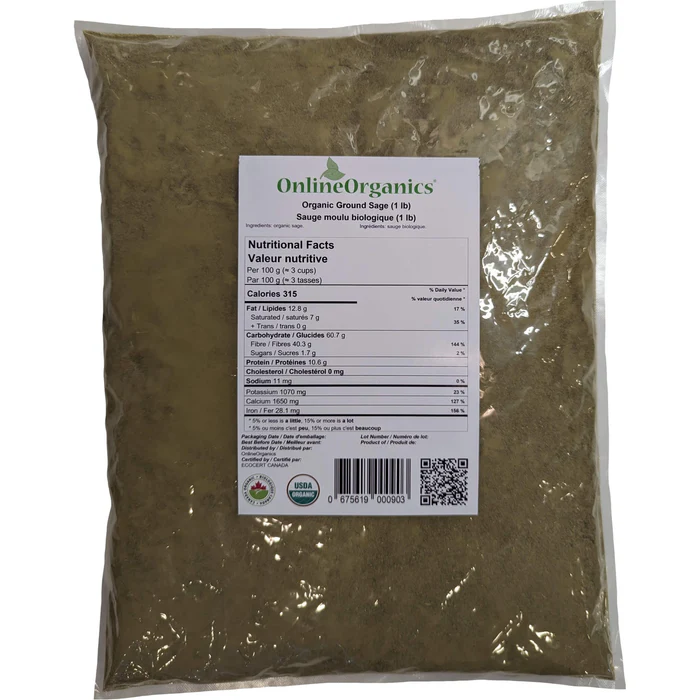
Organic Ground Sage
Original price
$0
Original price
$14.64
-
Original price
$435.83
Original price
Current price
$14.64
$14.64
-
$348.67
Current price
$14.64
0.454kg | $38.44 / kg
| $17.44 / lb
Availability:
Only 1 left!
Availability:
Out of stock
Availability:
Special Order
To ensure an exceptional price and freshness, we keep our standing inventory to a minimum. Please note that there can be up to a 3-week lead time.
Availability:
Out of stock
Availability:
Special Order
To ensure an exceptional price and freshness, we keep our standing inventory to a minimum. Please note that there can be up to a 3-week lead time.
Availability:
Out of stock
Specifications (Tap to open):
Category:
Shelf Life:
Country of Origin:
Allergen Information (Tap to open):
We take your health and safety very seriously. If you have any allergen inquiries please Contact Us.
If an allergen is present in the product, it will be clearly declared in the ingredients.
"May Contain" statement NEW FOR 2025 (Progressive rollout):
- In 2025 we will be progressively updating our labels and product pictures with our new label that now include a "May Contain" statement.
- The Canadian Food Inspection Agency (CFIA) dictates that "Cross-contamination statements may be declared by food manufacturers and importers".
- That said, we hold ourselves to much higher standards than the CFIA and Health Canada rules oblige. Most companies do not and you will only rarely see "May Contain" statements.
- If there is a remote chance that there might be cross-contamination of a priority allergen, we will declare it on the product label in the form of a "May Contain" statement.
- A "May Contain" statement does not mean that the allergen is present in the product, it is simple a precautionary measure we take to stay the most transparent possible.
- If an allergen is present in the product, it will be clearly declared in the ingredients.
- For example our Quebec made flours come from a mill that makes both oat and wheat flours. Since both allergens are present in the mill we automatically declare the possibility of cross-contamination even if all precautionary measures are taken.
- Only priority allergens are declared in the "May Contain" statement, which are:
- Cereals & Grains: Triticale, Barley, Oats, Rye, Wheat.
- Tree Nuts: Almonds, Brazil Nuts, Cashews, Hazelnuts, Macadamia Nuts, Pecans, Pine Nuts, Pistachios, Walnuts.
- Peanuts
- Sesame
- Eggs
- Milk
- Soy
- Mustard
- Fish
- Seafood: Crustaceans, Molluscs.
- Sulphites
- Priority allergens are decided by government agencies and health boards. To read more on the subject see "Common food allergens - Priority allergens" published by the CFIA.
- Full CFIA cross-contamination statement explanation "Food allergen cross-contamination (or precautionary) statements".





Our organic sage powder is renowned for its effects on strengthening memory. It is also an excellent stimulant and antioxidant drink. Its fine and full flavor brings harmony to the body and mind.
What is sage?
- Sage "Salvia officinalis" is an herb that is prized for its strong herbal aroma and earthy flavor. It is used in savory recipes and is a common ingredient in holiday stuffing.
- Sage is an evergreen shrub part of the mint family. It has oval, dusty gray-green leaves with woody stems. Because of the fine, velveteen hair-like projections on sage leaves, they have a slightly fuzzy or fluffy appearance and cottony texture, which can make it unpleasant to eat raw.
- Sage has a unique flavor that brings warmth and complexity to dishes. It works well when combined with other herbs and complements a variety of foods, from meat and seafood to lemon and butter. Both the leaves, fresh and dried, as well as rubbed and powdered versions are used in recipes.
- Sage has a very long history and has been used since ancient times for several purposes, from warding off evil to boosting female fertility. It originated in the Mediterranean and was noted as being one of the most important herbs of that time period. Sage was utilized by the Romans to assist in digestion and was also used to treat ulcers, wounds, and sore throats.
General Storage Tips:







